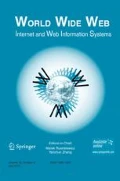Abstract
Effectively capturing the status information and improving situational awareness is the most important task in disaster information management. Due to the rapid increase of online information, this task becomes very challenging. Existing information retrieval and text summarization methods can solve information overload problem to some extent, however, they suffer from some limitations: lacking theme structure, ignoring spatial information, and unable to update information on the real time events. In this paper, we propose a dynamic disaster storyline generation framework, which generates a global storyline describing the evolution of the disaster events in the high-level layer and provides condensed information about specific regions affected by the disaster in the local-level layer. The proposed framework considers both uniqueness and relevance for representative document selection, uses Maximal Marginal Relevance to generate summaries from each local document set, and utilizes dynamic Steiner tree to implement the information update. Comprehensive experiments on typhoons data sets demonstrate the effectiveness of the proposed methods in each level and the overall framework.










Similar content being viewed by others
References
Balaji, J., Geetha, T.V., Parthasarathi, R., et al.: Abstractive summarization: a hybrid approach for the compression of semantic graphs[J]. Int. J. Semant. Web Inf. Syst. 12(2), 76–99 (2016)
Bhatia, N., Jaiswal, A.: Trends in extractive and abstractive techniques in text summarization[J]. Int. J. Comput. Appl. 117(6), 21–24 (2015)
Charikar, M., Chekuri, C., Cheung, T., et al.: Approximation algorithms for directed Steiner problems[J]. J. Algorithm. 33(1), 73–91 (1999)
Chatterjee, K., Saleem, K., Zhao, N., et al.: Modeling methodology for component reuse and system integration for hurricane loss projection application[C]. In: International Conference on Information Reuse and Integration (IRI), pp. 57–62 (2006)
Cheung, J.C.K.: Comparing abstractive and extractive summarization of evaluative text: controversiality and content selection[J]. B. Sc.(Hons.) Thesis in the Department of Computer Science of the Faculty of Science, University of British Columbia (2008)
Erkan, G., Radev, D.R.: LexPageRank: prestige in multi-document text summarization[C]. In: International Conference on Empirical Methods in Natural Language Processing, pp. 365–371 (2004)
Huang, J., Peng, M., Wang, H., et al.: A probabilistic method for emerging topic tracking in Microblog stream[J]. World Wide Web 20(2), 325–350 (2017)
Imase, M., Waxman, B.M.: Dynamic Steiner tree problem[J]. SIAM J. Discret. Math. 4(3), 369–384 (1991)
Kumaran, G., Allan, J.: Text classification and named entities for new event detection[C]. In: International ACM Sigir Conference on Research and Development in Information Retrieval, pp. 297–304 (2004)
Li, L., Wang, D., Shen, C., et al.: Ontology-enriched multi-document summarization in disaster management[C]. In: International ACM Sigir Conference on Research and Development in Information Retrieval, pp. 819–820 (2010)
Li, L., Li, T.: An empirical study of ontology-based multidocument summarization in disaster management. IEEE Trans. Syst. Man Cybern. Syst. 44(2), 162–171 (2014)
Lin, C.Y., Hovy, E.: Automatic evaluation of summaries using n-gram co-occurrence statistics[C]. In: Proceedings of the 2003 Conference of the North American Chapter of the Association for Computational Linguistics on Human Language Technology. Association for Computational Linguistics, vol. 1, pp. 71–78 (2003)
Lin, C., Lin, C., Li, J., et al.: Generating event storylines from microblogs[C]. In: Proceedings of the 21st ACM International Conference on Information and Knowledge Management, pp. 175–184. ACM (2012)
Mei, Q., Zhai, C.: Discovering evolutionary theme patterns from text: an exploration of temporal text mining[C]. In: International ACM Sigir Conference on Knowledge Discovery and Data Mining, pp. 198– 207 (2005)
Radev, D.R., Jing, H., Budzikowska, M., et al.: Centroid-based summarization of multiple documents: sentence extraction, utility-based evaluation, and user studies[J]. In: North American Chapter of the Association for Computational Linguistics, pp. 21–30 (2000)
Ren, Z.M., Shao, F., Liu, J.G., et al.: Node importance measurement based on the degree and clustering coefficient information[J] (2013)
Tran, G.: (L3S Research Center and Leibniz University Hannover, Appelstr. 9, Hannover, Germany); Alrifai, Mohammad; Herder, Eelco Source: Lecture Notes in Computer Science (including subseries Lecture Notes in Artificial Intelligence and Lecture Notes in Bioinformatics), vol. 9022, pp. 245–256 (2015)
Wang, D., Li, T., Ogihara, M.: Generating Pictorial Storylines Via Minimum-Weight Connected Dominating Set Approximation in Multi-View graphs[c]. AAAI (2012)
Yan, R., Wan, X., Otterbacher, J., et al.: Evolutionary timeline summarization: a balanced optimization framework via iterative substitution[C]. In: International ACM Sigir Conference on Research and Development in Information Retrieval, pp. 745–754 (2011)
Zhou, W., Shen, C., Li, T., et al.: Generating textual storyline to improve situation awareness in disaster management[C]. In: 2014 IEEE 15th International Conference on Information Reuse and Integration (IRI), pp. 585–592. IEEE (2014)
Zhou, Q., Yuan, R., Li, T.: An improved textual storyline generating framework for disaster information management[C]. In: 2017 12th International Conference Intelligent Systems and Knowledge Engineering (ISKE). ISKE, p. 8258738 (2017)
Acknowledgments
This work is supported by the Natural Science Foundation of Fujian Province (China) under Grant No. 2017J01118 and Shenzhen Science and Technology Planning Program under Grant No. JCYJ20170307141019252.
Author information
Authors and Affiliations
Corresponding author
Additional information
Publisher’s Note
Springer Nature remains neutral with regard to jurisdictional claims in published maps and institutional affiliations.
This article belongs to the Topical Collection: Special Issue on Big Data for Effective Disaster Management
Guest Editors: Xuan Song, Song Guo, and Haizhong Wang
Rights and permissions
About this article
Cite this article
Yuan, R., Zhou, Q. & Zhou, W. dTexSL: A dynamic disaster textual storyline generating framework. World Wide Web 22, 1913–1933 (2019). https://doi.org/10.1007/s11280-018-0640-8
Received:
Revised:
Accepted:
Published:
Issue Date:
DOI: https://doi.org/10.1007/s11280-018-0640-8




